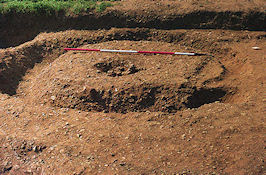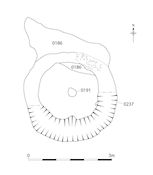

Figure 31: Ring-ditch (0237): possible hut (1979 interpretation) or barrow.
Figure 32: Plan of ring-ditch 0237.
Iron Age Site Description (1979)
There was in the 1970s a tendency for fences to be readily identified as palisades and enclosures as defensive. This terminology was in use even where there was no real intent to understand the enclosures in any quasi-military way. One change that has been made to the original text has been to replace 'rampart' with the more neutral term 'bank'. The former term was used with its strong defensive implications, oddly it may seem, without it really being considered to be a military term. This is undoubtedly a result of the dominance of hillfort studies in the discipline. Whatever was happening inside the enclosure at Blackstone, the bank and ditch on their own were not seriously defensive. The creation, maintenance and improvement of the enclosure was probably originally equivalent to only little more than a simple fence, and so was a statement of ownership and a degree of prestige, and, therefore, a claim to status. While this might mimic in a lesser degree a military form, it was no more a serious military construction than in the case of a small medieval moated site. Its functional role, along with the gateway (to which with remarkable theoretical foresight, a symbolic role was suggested in the original text), would be to define the place, enable access by humans and animals to be controlled and, like a garden wall or hedge, proclaim ownership.
The recognition of post-settings in the fills of the inner ditch leads to the obvious question of whether the ditches were replaced by a fence line, or palisade. It may be that the choice of terminology in 1979 was influenced by academic fashion, but this is hardly a failing avoided by any generation of archaeologists, including the current one. This aside, it was felt that the recognition of such evidence in a number of trenches and observations across the inner ditch provided enough evidence for a hypothesis that a fence-line had been created (and in part renewed) along the top of the filled inner ditch. Given the structure of the report, this hypothesis may have been presented too firmly. It was no doubt influenced by the publication of box ramparts and palisades at a number of sites at the time, based on 'representative', widely spaced sections across hillfort and similar defences. The original authors still favour the conclusion, on balance, that these fence-lines existed at Blackstone, and that the related post-settings certainly did. It will remain arguable whether such structures were completed or continuous, and whether indeed they were appropriately termed 'palisades', and could, therefore, be seen as an upgrading of the outer circuit to provide greater resistance to casual assault, especially by mounted opposition.
Roundhouses are now (2008) seen to be the more standard late Iron Age building found at sites in the wider middle Severn valley (e.g. Wychbold, near Droitwich; Jones and Evans 2006), and where more examples have been recorded in the Midlands, for instance in Warwickshire, they are counted as typical throughout the Iron Age (Hingley 1996, 16). They are also found in the hillforts of Worcestershire (e.g. Conderton Camp; Thomas 2005, 59-77). In the broader region they have also been established as continuing into the Roman period (e.g. in the Avon valley at Norton and Lenchwick and at Throckmorton; Jackson et al. 1996, and Griffin et al. 2005 respectively). However, at Blackstone they are conspicuous by their elusiveness.
Where roundhouses were defined at Blackstone in 1979, based on posthole patterns, they are now far from convincing, despite the most credible being the only ones retained, and indeed the 'gully' roundhouse, so-called because of its most characteristic feature, seems to be wholly absent. It may be that, on the sandy and well-drained subsoil here, ring-gullies for drainage would be unnecessary, though this does sound like special pleading. Alternatively, other Iron Age house types should be considered, such as that based around posts with the outer walls being turf-built, for instance, which would leave little archaeological trace (cf. Cunliffe 2005, 271). Even then there are no strikingly obvious examples, though further spatial analysis of features, especially if computer-aided, may be able to identify such structures. In particular it is noted that a large central domestic house (cf. Little Woodbury, Wilts; Bersu 1940) seems to be absent, although it is possible that a roundhouse could have remained undiscovered in an unexcavated area in the north-west part of the enclosure. Where possible structures were identified, their partial and insubstantial character (e.g. Building 1) may be more in keeping with shelters used while craftworking, rather than being ordinary domestic buildings, and this could also relate to the unusual contents of nearby pit 0098. While there was no proof of craftworking, the faint traces of smithing, for instance hammerscale, might have been missed during excavation in the 1970s (see below).
However, it may be that Blackstone will turn out to be locally unusual in respect of its buildings, and that this is the key to understanding its function (see Site Discussion), or it may be that north Worcestershire generally had a different Iron Age character. Clearly the excavation of other sites of similar date is urgently required in the region in order to address this fundamental issue further.
It is certainly the case that pits on Iron Age sites (or at least their infilling) are now viewed as being the result of rather more complex processes than was realised in 1979. The reworking of the pottery report prior to publication has resulted in the recognition of clear patterning of deposition across the site. The already noted atypical concentrations of material in pits 0098 and 0080 indicate pit filling processes similar to those seen in middle to late Iron Age sites in the lowland zone, suggesting structured or special deposits of material in and around pits. The detailed interpretation of these deposits is a question for discussion, but there is little doubt that the material from at least these pits represents an intriguing yet common behaviour of great interest (see Site Discussion).
The evidence for slags, which formed, for instance, an element of the discussion of pit 0098, is now seen (in the absence of specialist study of any of this material, and in light of recent work) to be best interpreted as fuel ash from domestic hearths, rather than from iron working. Iron working is not disproved thereby, but can no longer be put forward on the basis of the evidence recovered. These residues rather contribute to the discussion on the sources of pit fills, and the question whether, for instance, material was being curated in middens prior to deposition in the pits. For further discussion of this pit in particular, and its possible votive purpose, see Site Discussion.
A small ring-ditch (0237; Figs. 11, and 31-2) had an internal diameter of only about 2m and a small pit in the centre (0191); it cut an earlier elongated feature on its north side. Although only a partial circumference, an adjacent gully (0234) looked to be of very similar proportions and also had a central pit (0594). The ring-ditch was associated with Iron Age finds. The interpretation of these features was problematic. As ring-ditches they would typically represent the remains of round barrows, but there was no corroborative bone evidence, though this may have been due to the aggressive soil conditions.


Figure 31: Ring-ditch (0237): possible hut (1979 interpretation) or barrow.
Figure 32: Plan of ring-ditch 0237.
© Internet Archaeology/Author(s)
URL: http://intarch.ac.uk/journal/issue28/3/3.3.1.html
Last updated: Wed July 21 2010